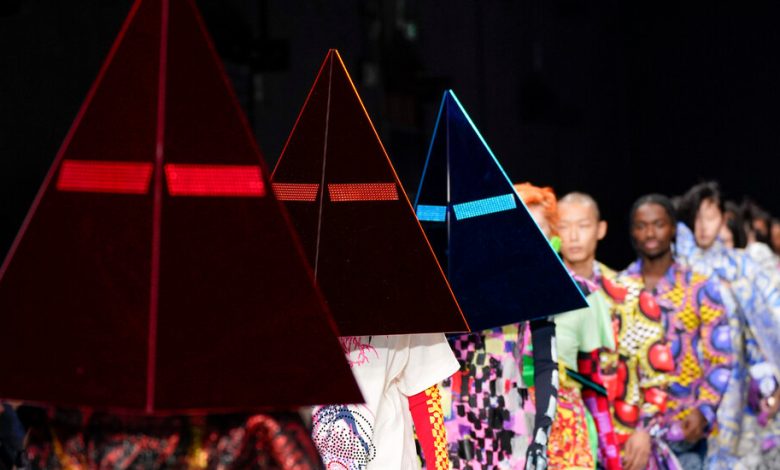Matty Bovan Brings Milan to Life

MILAN — Backstage at the Matty Bovan show at the tail end of Milan Fashion Week, Stefano Gabbana of Dolce & Gabbana was hugging Mr. Bovan, the young British designer, and beaming with excitement. “This brings new energy for Milan!” said Mr. Gabbana happily.
He was wearing a black sweatshirt and black sweatpants and standing next to Domenico Dolce, who was in his own black hoodie and black pants looking equally enthused. And he was right.
It had been Messrs. Dolce and Gabbana’s idea to bring Mr. Bovan to Milan — they contacted him after Mr. Gabbana started following Mr. Bovan on Instagram and offered their support — but it wasn’t clear whether anyone had realized quite what a jolt of life Mr. Bovan’s riotous amalgamations of materials and meaning would provide.
Or how much they’ve been needed, to cut through the dense smog of ubiquitous leather trench coats and Agnelli worship that seems to clog the fashion air of this city. No matter the number of young (or youngish) designers who arrive at old houses, it often seems to cloud their eyes.
There’s simply too much reverence around the myth of Made in Italy; too much dutiful allegiance to the brand.
Even at Ferrari, which has no particular track record with clothes (other than a bunch of licensed prancing-horse sweatshirts), the designer Rocco Iannone seems trapped in the chassis. Despite breaking away from some of the more literal racecar elements referenced in his last two collections (a good thing), this season’s focus on streetwear silhouettes, Ferrari colors in an electric yellow and indigo ozone denim wash and ombre’d sequins that suggested cars racing into the horizon as the horizon extends toward infinity, was bumpy. Like the Ferrari hardware (screws and bolts straight off the assembly line) that had been embedded with shiny stones for gleam and married to — yes, beige — driving glove leathers.
The problem is that Ferrari is still making merch: merch to wear for cocktails at Cipriani, to be sure, but merch nonetheless. Imagine if it actually made fashion, focused on the abstract notion of speed and racing forward. Ferrari sets trends in automotive design, rather than following them. So why, when it comes to clothes, does the brand do the opposite?
It’s one thing if you are Giorgio Armani, and you’ve established the tone in the first place, to talk about (as his show notes went) “coherence” and how a “fine thread links one collection to the next.” It’s one thing to iterate faithfully with soft tailoring and gleam that this season seemed to reflect the entire Milky Way, as well as the Armani ouevre, in skylight washes of hazy blue and indigo and a host of twinkling fairy light frocks. And, to be fair, some nods to recent comfort dressing in the form of elastic-waist sweatpants in organza, silk and sheer under pretty much everything (plus, in an expected twist, a skirt that attached on either side to each leg with what looked like an … ankle cuff?).
But every time a new designer pledges his troth on the altar of the well-behaved leather coat, it seems like a missed opportunity.
Which is why the fact there was no such leather in sight at Mr. Bovan’s show was so invigorating.
Instead there were collaged amalgamations of fabric and form: giant apples on checkerboard prints, bulging panniers covered in sequins and different graphic prints over ripped and reconstituted denim, fluted skirts and giant, royal brocades. Removable hi-def leg o’ mutton sleeves tied on over corsetry that looked like it had been made of old kitchen towels. Even giant Plexiglas pyramids entirely hiding the heads of the last three models. It was completely weird and wacky and very wonderful.
And despite how nuts the collection looked, entirely considered. Mr. Bovan calls his approach “harnessed chaos,” which is a pretty good description. The denim was old Dolce & Gabbana leftovers; the corsets, styles that came from their archives that had been reissued for Mr. Bovan and hand-painted by the designer; most of the fabric was patched-together deadstock; and the majority of the collection was Made in York (England), exuding the fabled “touch of the hand.”
It offered both a reconsideration of what exactly those values mean and how they can be expanded for the current world — not to mention broader social themes of punk, royalty and inclusivity — and a possible answer. It may not look like what anyone is used to. But shouldn’t that be the point?
